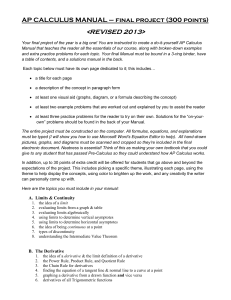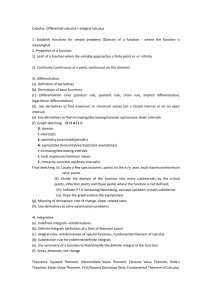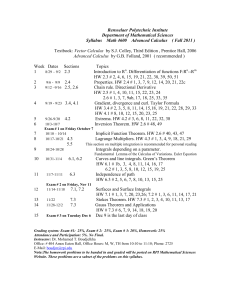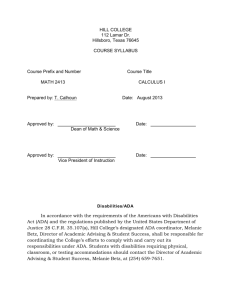Calculus Course Expectations
advertisement
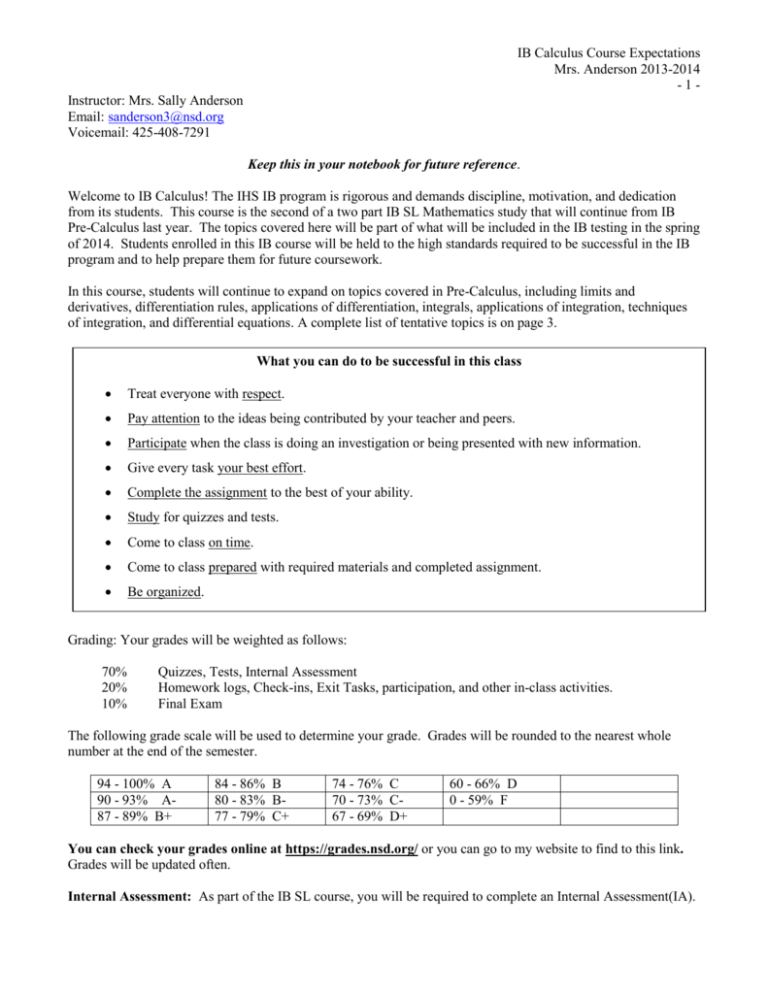
IB Calculus Course Expectations Mrs. Anderson 2013-2014 -1Instructor: Mrs. Sally Anderson Email: sanderson3@nsd.org Voicemail: 425-408-7291 Keep this in your notebook for future reference. Welcome to IB Calculus! The IHS IB program is rigorous and demands discipline, motivation, and dedication from its students. This course is the second of a two part IB SL Mathematics study that will continue from IB Pre-Calculus last year. The topics covered here will be part of what will be included in the IB testing in the spring of 2014. Students enrolled in this IB course will be held to the high standards required to be successful in the IB program and to help prepare them for future coursework. In this course, students will continue to expand on topics covered in Pre-Calculus, including limits and derivatives, differentiation rules, applications of differentiation, integrals, applications of integration, techniques of integration, and differential equations. A complete list of tentative topics is on page 3. What you can do to be successful in this class Treat everyone with respect. Pay attention to the ideas being contributed by your teacher and peers. Participate when the class is doing an investigation or being presented with new information. Give every task your best effort. Complete the assignment to the best of your ability. Study for quizzes and tests. Come to class on time. Come to class prepared with required materials and completed assignment. Be organized. Grading: Your grades will be weighted as follows: 70% 20% 10% Quizzes, Tests, Internal Assessment Homework logs, Check-ins, Exit Tasks, participation, and other in-class activities. Final Exam The following grade scale will be used to determine your grade. Grades will be rounded to the nearest whole number at the end of the semester. 94 - 100% A 90 - 93% A87 - 89% B+ 84 - 86% B 80 - 83% B77 - 79% C+ 74 - 76% C 70 - 73% C67 - 69% D+ 60 - 66% D 0 - 59% F You can check your grades online at https://grades.nsd.org/ or you can go to my website to find to this link. Grades will be updated often. Internal Assessment: As part of the IB SL course, you will be required to complete an Internal Assessment(IA). IB Calculus Course Expectations Mrs. Anderson 2013-2014 -2Quizzes and Tests: Quizzes will be given periodically covering some of the concepts studied during the unit. Tests will be given at the end of each unit, covering most of the concepts in the unit along with information from previous tests. There are no retakes on quizzes and tests. However, it is important that you understand the material being presented in class. Each student will have one opportunity per test to “fix” errors after an exam for a small portion of points. Note that quizzes are not included. This opportunity must be taken advantage of within one week of receiving your graded test, and will be given after school during my office hours. Further details will be discussed in class. A cumulative final exam will be given at the end of first semester. It is important to note that once a quiz or test has begun, you will not be permitted a break until your assessment is turned in. Homework: Homework assignments will be given daily. Assignments will be checked in class before we discuss them. To earn full credit on the assignment, the student must have ALL of the assignment complete with work shown at the beginning of class. Students will be required to keep homework assignments separate from their notes. I recommend you use a spiral type of notebook for assignments to make studying more convenient. It is crucial that you stay on top of your homework in this high level and fast paced course. Late assignments will not be accepted for credit. Attendance: If a student has an excused absence, s/he will have the same number of days to make up the assignment as s/he was absent. It is the student's responsibility to obtain notes and assignments missed during their absence. If a student has an excused absence on the day of an announced quiz or test, then the student must be prepared to make it up immediately upon returning to school. Make up tests and quizzes must be scheduled with Mrs. Anderson on the day you return to class and will not be taken during class time. There will be no opportunity to make up work due to an unexcused absence. Tardiness: Being prompt and ready to go is essential to get the most out of class. You are expected to in your seat with homework out ready for class when the bell rings. Walking in tardy disrupts everyone in class. Consequences for tardiness will be as follows: 1st Tardy = warning; 2nd and 3rd = detention; 4th = referral to your administrator. Required Materials: Students will need to bring to class every day: pen, pencil, notebook paper, graphing paper, and a graphing calculator. I recommend the TI-83 plus or TI-84 graphic calculators. Please let me know if acquiring one is a hardship. The library has a few graphing calculators that can be checked out to students for the school year. I recommend that you go to the library as soon as possible. Classroom Rules: All school rules will be enforced within the classroom. Do not bring food or drink into the classroom. However, water bottles are acceptable. I-pods, cell phones, and other electronic devices will not be tolerated and are to be put away for the ENTIRE class period. Cell phones and texting are extremely distracting to everyone in the room and disrupts your learning process. This will NOT BE TOLERATED during class whatsoever. Refer to your handbook for discipline policy regarding cell phone use and note that I will enforce IHS policy completely. Textbooks: Each student will be issued a copy of Stewart’s Single Variable Calculus Early Transcendentals with Vector Functions 7E, AP Edition. The Calculus textbooks are new this year. Replacement cost for the book is about $151. Because these are new books, any damage to the book will be fined the full cost, so please be careful with your book, cover it, and avoid water damage. It is important to note that water damage of any kind on the textbook will charged the full replacement cost of the book. You will not be required to bring your book to school daily. An electronic version of this book will hopefully be made available to all students. Academic Honesty/Integrity: Doing your own work is critical to understanding the material. IHS and IB take academic honesty and integrity extremely seriously. Infractions can include the obvious like: Looking at another students test, copying any part of someone else’s test, or using cheat-sheet notes on a test. Some of the not-quite-so-obvious: Copying any part of someone else’s homework, sharing what you saw on a test with IB Calculus Course Expectations Mrs. Anderson 2013-2014 -3another student who has not yet taken that assessment, posting possible questions that you may have seen on a Facebook. It is important to note that whether you were the one doing the sharing or the copying, both students will face consequences. Refer to your handbook for IHS Policy. Basically, DON’T DO IT! If you have questions about whether something could be seen as cheating, please come talk to me. Also, if you know of something that does not look right, please let me know. Extra Credit: Because this is an IB course, there will be NO opportunity for extra credit. Office Hours: The best way to reach me is through e-mail at the above address. I am generally here every day after school until at least 2:30. Generally, I will be available Thursdays after 7th period. Please make sure to touch base with me if you are planning to come see me. Topics to Standards: The topics we will cover are connected to specific mathematical concepts that are identified in state standards. Washington adopted the Common Core State Standards for mathematics in July 2011. We are in the period of transition from prior standards to fully implementing the new standards in 2014. The Common Core State Standards can be found at http://www.k12.wa.us/CurriculumInstruct/learningstandards.aspx. Topics to be covered (and section number): Limits and Derivatives Limit of a function 2.2 • Intuitive definition – one and two sided limits • Infinite limits • Vertical Asymptotes Calculating limits using the limit laws 2.3 • Direct substitution • Squeeze Theorem Continuity 2.5 • Definition of continuity at a point • Continuity on an interval • Types of functions continuous for all x in domain • Continuity of composite functions • Intermediate Value Theorem Limits at infinity; horizontal asymptotes 2.6 • Definition of • Horizontal asymptote • Infinite limits Derivatives and rates of change 2.7 • Definition of derivative • Average and instantaneous rate of change The Derivative as a function 2.8 • Derivative symbols • Differentiability implies continuity • Types of discontinuity • Higher derivatives Differentiation Rules Derivatives of polynomials and exponential functions 3.1 • Derivative of constant • Derivative of a power function • Derivatives of sums and differences of functions • Derivative of exponential functions The product and quotient rules 3.2 • Derivative of a product of two functions IB Calculus Course Expectations Mrs. Anderson 2013-2014 -4• Derivative of a quotient of two functions Derivatives of Trig functions 3.3 • Limits of • Derivatives of six basic trig functions The chain rule 3.4 • Derivative of a composite function Implicit differentiation 3.5 • Definition of an implicit function • Using the chain rule to differentiate implicitly • Derivatives of the six inverse trig functions Derivatives of log functions 3.6 • Implicit differentiation to get derivative of log function • Logarithmic differentiation Rates of change in the natural and social sciences 3.7 • Distance, velocity, acceleration - physics • Exponential growth rate – biology • Marginal cost – economics Exponential growth and decay 3.8 • Population growth • Radioactive decay • Newton’s law of cooling • Continuously compounded interest Related Rates 3.9 Linear approximation and differentials 3.10 • Use a line to approximate the value of a function • Use a differential to approximate the change in a function • Relative error and percent error Applications of differentiation Maximum and minimum values 4.1 • Definition of local and absolute max and min • Extreme value theorem • Fermat’s theorem • Critical number Mean Value Theorem 4.2 • Rolle’s Theorem • Mean Value Theorem for derivatives • Corollaries of MVT How derivatives indicate the shape of a graph 4.3 • Increasing/decreasing function test • First derivative test • Concavity • Inflection point • Second derivative test Indeterminate forms and L’Hôpital’s Rule 4.4 • Different types of indeterminate forms • Finding limits of indeterminate forms Summary of curve sketching 4.5 Optimization problems 4.6 • Setting up and solving max/min problems Newton’s method 4.8 • Approximating roots of functions IB Calculus Course Expectations Mrs. Anderson 2013-2014 -5• Approximating points of intersection of functions Antiderivatives 4.9 • Find the antiderivative of a function Integrals Area and the definite integral 5.1, 5.2 • Approximating area under a curve • Riemann sum • Definition of definite integral • Properties of definite integrals Fundamental Theorem of Calculus 5.3 • Fundamental theorem part 1 • Fundamental theorem part 2 • Differentiation and integration inverse processes Indefinite integrals 5.4 • Integral as a family of functions • Net change theorem Substitution rule 5.5 • Integration using substitution Applications of Integration Areas between curves 6.1 • Finding the area between two functions of x or y Volumes 6.2, 6.3 • Cross-sections to get volume • Volume using disks • Volume using washers • Volume using shells Average value of a function 6.5 • Use an integral to find the average functional value • Mean Value Theorem for integrals Techniques of Integration Integration by parts 7.1 • Parts formula • Table method Trigonometric substitution 7.3 • Right triangle to assist in integrating Integration of rational functions by partial fractions 7.4 • Denominators containing linear factors (repeated) Approximating integration 7.7 • Trapezoidal rule • Approximating area from function and table Improper integrals 7.8 • Infinite limits of integration • Integrating over discontinuities Differential Equations Direction Fields 9.2 • Definition of differential equation • Solve a DE using a direction or slope field Separable equations 9.3 • Solve separable differential equations • Applications We will also have a short unit on vectors!! IB Calculus Course Expectations Mrs. Anderson 2013-2014 -6Resources: Edmodo: www.edmodo.com This is the primary source of information for class. You will be able to look here for homework, copies of worksheets, and notes. This will be especially useful if you are absent. This is also a place for you to post questions about the homework and you can contact me directly through this website. If you do not have an account yet, go to the address above and follow the directions for setting up an account. Once you have an account, you can log into our classroom site by using the group code below. Record the following information and keep it with you. Sign-in information: User Name: ___________________ Password: __________________ Group code for this class is: _________ Parent Code: ____________ You will need to go to your setup and enter an email or phone number for messages. I will occasionally send out messages using edmodo, so make sure that you supply something that you check often. If you have free texting, this might be the best option. IB Calculus Course Expectations Mrs. Anderson 2013-2014 -7- IB Calculus Course Syllabus Acknowledgement It is a required homework assignment to have both your signature and your parent's signature on this last page. I have read the entire IB Calculus course syllabus and discussed it with my parent(s). I am aware that the syllabus should remain in my notebook for reference throughout the year. I have read and completely understand the consequences of using my cell phone in class and understand the expectation of complete academic honesty and integrity. I know I can reach Mrs. Anderson, using the information provided on the first page, if I have additional questions. I understand that I will pay for any damage done to my textbook. Student Signature Parent Signature Please print student name Please print parent name Parent’s phone Email address Work phone Additional Comments or Concerns?



